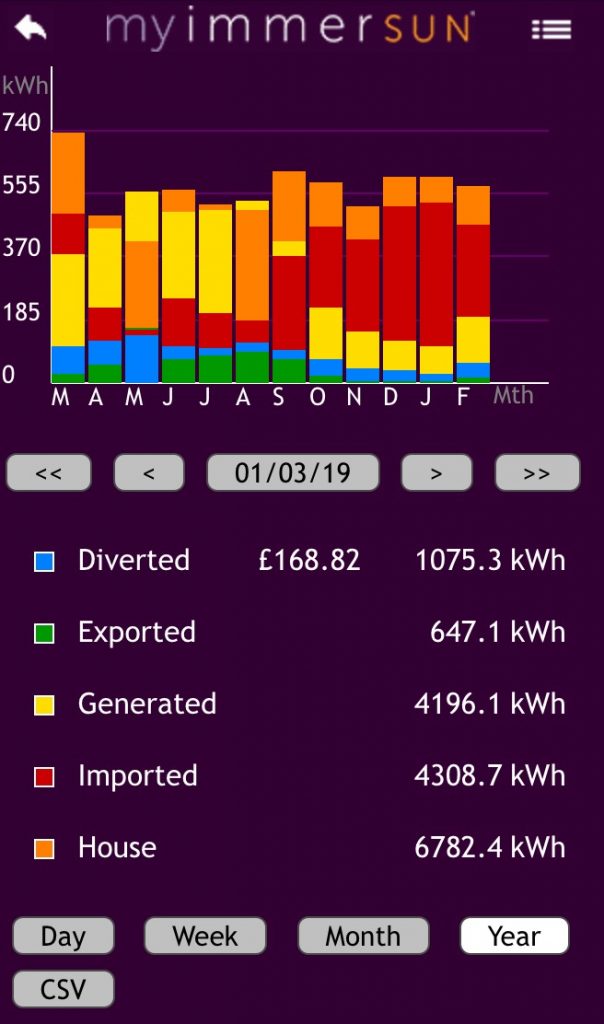I’ve been seeing a few online advertisements recently touting 70% savings on electricity through a combination of solar panels and battery storage. I’ve also been looking for a way to express my savings through my smart tariff so this seemed like a opportunity to try that.
My start point is a years data from my monitoring system..

I also went through a year of electricity bills (with slightly different start and end dates) concluding that my average purchased electricity cost was 7.08 p/kWh. Thus my average electricity costs (including solar) are on the right of the table below:
| source | quantity | est unit price | Est total | my uniT price | mY total | my saving v. Est |
|---|---|---|---|---|---|---|
| Bought | 4,309 kWh | 15.75 p/kWh | £678.67 | 7.08 p/kWh | £305.08 | £373.59 |
| Generated | 2,473 kWh | 15.75 pkWh | £389.50 | 0.00 p/kWh | £0.00 | £389.50 |
| Total / Average | 6,783 kWh | 15.75 p/kWh | £1,068.32 | 4.5 p/kWh | £305.23 | £763.09 |
If I look at the Energy Saving Trust’s assumptions as a baseline, they have the average UK cost of electricity as 15.75 p/kWh. If I’m paying an average 4.5 p/kWh for each kWh used with my combination of solar PV, storage battery and smart tariff then I’m paying 28.6% of the cost of someone who used the same amount of electricity bought at the average UK rate or saving 71.4% of electricity cost. To put it another way, I’m paying £305.23 for electricity that would have cost the average UK consumer £1,068.32 (on the left of the table above) – a saving of £763.09.
(The baseline assumption that someone would have used the same amount of electricity as me without my level of technology is a slight over-estimate as I flex water heating between gas and electricity since my bought electricity price is sometimes lower than my bought gas price causing me to substitute electricity for gas. Someone on a conventional electricity tariff and gas would never make that substitution as their gas would always be cheaper than their electricity, hence my electricity consumption is a little higher than someone who would be on a conventional electricity tariff.)
I’m also generating feed-in tariff due to the age of my system (approximately 4.5 years old) which would be £714.59 per annum at current rates, and making 1,075 kWh of hot water from surplus solar electricity which saves £38.22 in gas (the diverted / hot water saving in the screenshot above is based on a notional electricity price, not a gas price). Unless I’ve missed something that’s an annual return of £1,515.90 (£763.09 + £714.59 + £38.22).
In my previous post I estimated my investment at £8,670 so with an combined annual savings and revenue of £1,515.90 that’s a 17.5% return or a payback of 5.7 years. Previously I’d estimated 9 years including the battery, but this was without the benefit of the smart tariff. As we’ve now had the solar PV for 4.5 years that’s very promising, although as my return seems to be accelerating it will take more than 4.5 past years + 1.2 future years (total 5.7 years) to achieve payback.
The current 5.7 years to payback would have achieved payback in spring 2021 as the near bookend, while the prior 9 years would have been autumn 2024 as the far bookend. In practice I could not have achieved the lower bookend of 5.7 years, even had I invested in all the supporting technologies simultaneously, because I’m combining the legacy Feed-in Tariff (FiT) scheme for my solar PV with the Octopus Agile dynamic smart electricity tariff which started in February 2018,
